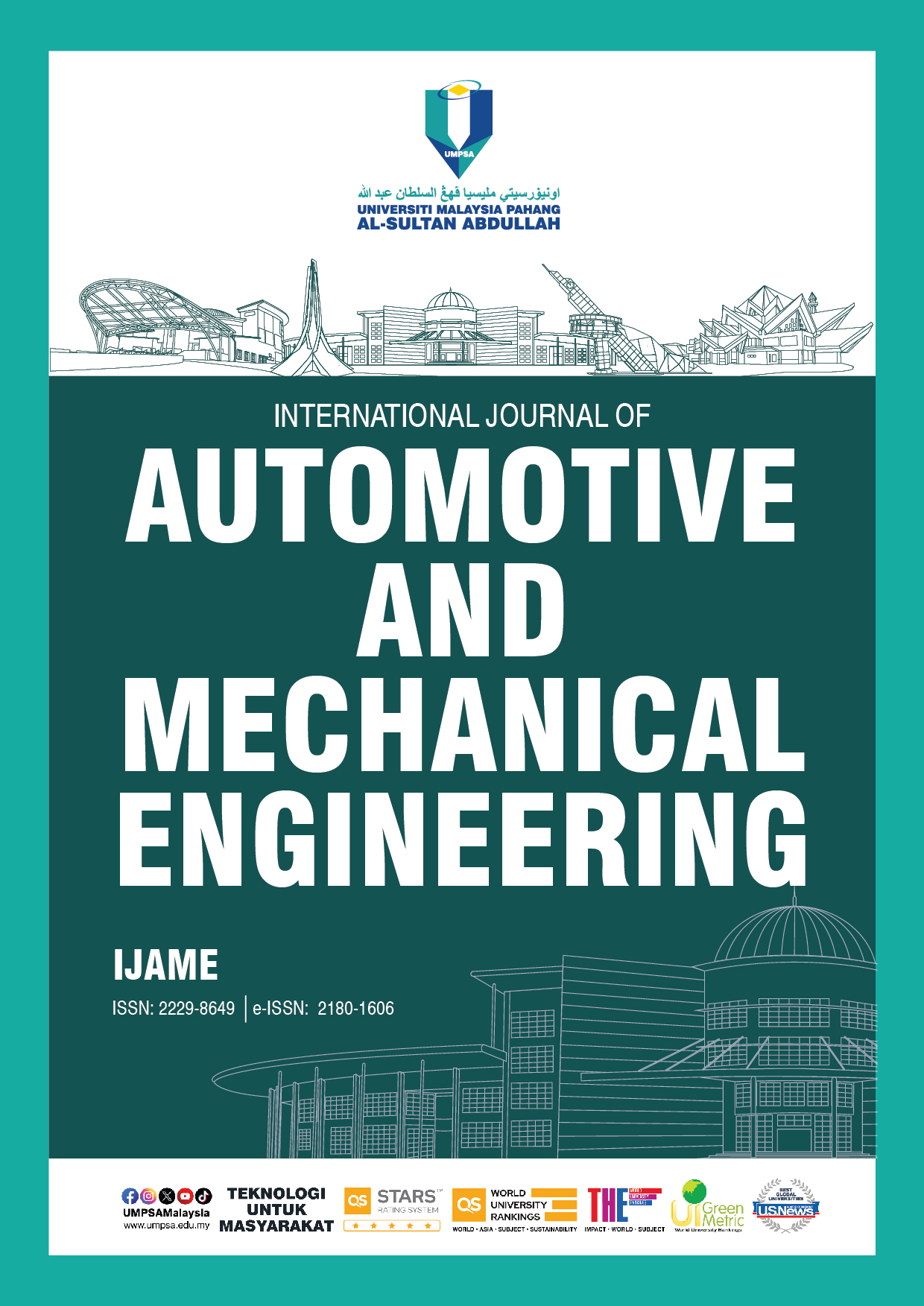Metamodel-based Hybrid Parametric Optimization with Static Prototype Validation for a Six-Axle Wheel Load Cell Design
DOI:
https://doi.org/10.15282/ijame.21.4.2024.9.0912Keywords:
Six-axle wheel load cell, Load cell, Metamodel, Parametric optimization, Static validationAbstract
The accurate measurement of forces and torques acting on a vehicle’s chassis, originating from wheel-pavement interactions, is essential for optimizing suspension systems, axles, and other structural components. A critical challenge in optimizing wheel load cell (WLC) design is to enhance sensitivity without compromising mechanical robustness. To address this question, this study developed a six-axis load cell designed to decouple force and torque measurements, achieving high sensitivity and reliability. The objective was to design an optimized WLC for multi-axis force measurement by maximizing sensitivity through a metamodel-based hybrid optimization framework. The methodology began with a fractional factorial Design of Experiments (DOE) to identify key parameters affecting load cell sensitivity and to define the optimization search space. This was followed by a dual-step parametric optimization process, utilizing the finite element method (FEM) to evaluate load cell performance and an inner-point optimization algorithm for convergence. After completing the DOE and FEM stages, the load cell was physically constructed and calibrated using a universal testing machine MTS 810, where experimental data closely matched simulation results, validating the design’s effectiveness. The main findings indicate that the optimized load cell can reliably measure six components, with a sensitivity increase of 14% compared to conventional designs. Numerical results from FEM analyses showed stress levels at 215 MPa, displacements around 0.16 mm, and a first-mode vibration frequency of 1351 Hz, meeting all structural integrity and performance requirements. Calibration confirmed minimal cross-talk effects, supporting the robustness of the final design. The developed load cell met optimal design criteria, showing substantial improvements in sensitivity and accuracy over existing designs, with potential applications in automotive, aerospace, and engineering testing.
References
[1] J.O. Templeman, B.B. Sheil and T. Sun, “Multi-axis force sensors: A state-of-the-art review,” Sensors and Actuators A: Physical, vol. 304, p. 111772, 2020.
[2] A.R. Tavakolpour-Saleh, A.R. Setoodeh, and M. Gholamzadeh, “A novel multi-component strain-gauge external balance for wind tunnel tests: Simulation and experiment,” Sensors and Actuators A: Physical, vol. 247, pp. 172–186, 2016.
[3] R.A.B. Almeida, D.C. Vaz, A.P.V. Urgueira, and A.R.J. Borges, “Using ring strain sensors to measure dynamic forces in wind-tunnel testing,” Sensors and Actuators A: Physical, vol. 185, pp. 44–52, 2012.
[4] A.R. Tavakolpour-Saleh and M.R. Sadeghzadeh, “Design and development of a three-component force/moment sensor for underwater hydrodynamic tests,” Sensors and Actuators A: Physical, vol. 216, pp. 84–91, 2014.
[5] A. Blakeborough, D. Clément, M. S. Williams, and N. Woodward, “Novel load cell for measuring axial force, shear force, and bending moment in large-scale structural experiments,” Experimental Mechanics, vol. 42, no. 1, pp. 115–122, 2002.
[6] E. Korkmaz, B. Bediz, B. A. Gozen, and O.B. Ozdoganlar, “Dynamic characterization of multi-axis dynamometers,” Precision Engineering, vol. 38, no. 1, pp. 148–161, 2014.
[7] Z. He and T. Liu, “Design of a three-dimensional capacitor-based six-axis force sensor for human-robot interaction,” Sensors and Actuators A: Physical, vol. 331, p. 112939, 2021.
[8] G.-S. Kim, “Development of a three-axis gripper force sensor and the intelligent gripper using it,” Sensors and Actuators A: Physical, vol. 137, no. 2, pp. 213–222, 2007.
[9] J.-H. Kim, “Multi-axis force-torque sensors for measuring zero-moment point in humanoid robots: A review,” IEEE Sensors Journal, vol. 20, no. 3, pp. 1126–1141, 2020.
[10] J. Humm, N. Yoganandan, J. DeRosia, K. Driesslein, J. Avila, and F. Pintar, “A novel posture control device to induce high-rate complex loads for spine biomechanical studies,” Journal of Biomechanics, vol. 123, p. 110537, 2021.
[11] B. Chen, P. Liu, F. Xiao, Z. Liu, and Y. Wang, “Review of the upright balance assessment based on the force plate,” International Journal of Environmental Research and Public Health, vol. 18, no. 5, p. 2696, 2021.
[12] A. Song and L. Fu, “Multi-dimensional force sensor for haptic interaction: A review,” Virtual Reality & Intelligent Hardware, vol. 1, no. 2, pp. 121–135, 2019.
[13] X.C. Akutain, K. Ono, F. Comolli, M. Gobbi, and G. Mastinu, “Further understanding of steering feedback and driver behavior through the application of an instrumented steering wheel,” in Proceeding of 10th International Munich Chassis Symposium 2019, Wiesbaden, Germany, pp. 481–502, 2019.
[14] M. Gobbi, F. Comolli, F.M. Ballo, and G. Mastinu, “Measurement data obtained by an instrumented steering wheel for driver model development,” Data in Brief, vol. 30, p. 105485, 2020.
[15] F. Ballo, M. Gobbi, G. Mastinu, and G. Previati, “A six-axis load cell for the analysis of the dynamic impact response of a hybrid III dummy,” Measurement, vol. 90, pp. 309–317, 2016.
[16] F. Ballo, M. Gobbi, G. Mastinu, and G. Previati, “Advances in force and moments measurements by an innovative six-axis load cell,” Experimental Mechanics, vol. 54, no. 4, pp. 571–592, 2014.
[17] M. Gobbi, M. Aiolfi, M. Pennati, G. Previati, F. Levi, M. Ribaldone, and G. Mastinu, “Measurement of the forces and moments acting on farm tractor pneumatic tires,” Vehicle System Dynamics, vol. 43, no. sup1, pp. 412–433, 2005.
[18] T.D. Gillespie, Fundamentals of Vehicle Dynamics, Warrendale, PA: SAE International, 1992.
[19] F. Cheli, F. Braghin, M. Brusarosco, F. Mancosu, and E. Sabbioni, “Design and testing of an innovative measurement device for tyre-road contact forces,” Mechanical Systems and Signal Processing, vol. 25, no. 6, pp. 1956–1972, 2011.
[20] G. Mastinu, M. Gobbi, and G. Previati, “A new six-axis load cell. Part I: Design,” Experimental Mechanics, vol. 51, no. 3, pp. 373–388, 2011.
21] G. Lin, W. Zhang, F. Yang, H. Pang, and D. Wang, “An initial value calibration method for the wheel force transducer based on memetic optimization framework,” Mathematical Problems in Engineering, vol. 2013, p. 275060, 2013.
[22] D. Wang, G. Lin, and W. Zhang, “The new method of initial calibration with the wheel force transducer,” Sensor Review, vol. 34, no. 1, pp. 98–109, 2014.
[23] O.M.M. Nouwens and P. S. Els, “Modeling, fabrication, calibration, and testing of a six-axis wheel force transducer,” M.S. thesis, Department of Mechanical and Aeronautical Engeneering, University of Pretoria, Pretoria, South Africa, 2013.
[24] G. Mastinu and M. Gobbi, “Force sensors for active safety, stability enhancement and lightweight construction of road vehicles,” Vehicle System Dynamics, vol. 61, no. 9, pp. 2165–2233, 2023.
[25] X. Yuan, D. Wang and L. Feng, “A nonlinear decoupling method for wheel force transducer with high-order polynomial model,” SAE Technical Paper 2024-01-5085, 2024
[26] L. Feng, S. Wang, J. Shi, A. Song, and P.X. Liu, “An interpretable nonlinear decoupling and calibration approach to wheel force transducers,” IEEE Transactions on Intelligent Transportation Systems, vol. 25, no. 1, pp. 225–236, 2023.
[27] J.-P. Brüggemann, L. Risse, S. Woodcock, G. Kullmer, and H. A. Richard, “Structural optimization of a wheel force transducer component for more realistic acquisition of vehicle load data and fracture mechanical evaluation,” Applications in Engineering Science, vol. 5, p. 100032, 2021.
[28] S. Chen, D. Wang, L. Feng, and W. Zhang, “Centralized load decoupling of a rotational multi-axis force sensor for measuring wheel-terrain interaction forces,” Measurement: Journal of the International Measurement Confederation, vol. 231, p. 114562, 2024.
[29] W. Ren, K. Yu, Y. Zhang, Y. Ge, and Y. Li, “Development and application of a novel high precision six-axis force/torque sensor,” IEEE Access, vol. 12, pp. 104585-104598, 2024.
[30] A.R. Ahmad, T. Wynn, and C.-Y. Lin, “A comprehensive design of six-axis force/moment sensor,” Sensors, vol. 21, no. 13, p. 4498, 2021.
[31] S.A. Liu and H.L. Tzo, “A novel six-component force sensor of good measurement isotropy and sensitivities,” Sensors and Actuators A: Physical, vol. 100, no. 3, pp. 223–230, 2002.
[32] L. Feng, G. Lin, W. Zhang, H. Pang, and T. Wang, “Design and optimization of a self-decoupled six-axis wheel force transducer for a heavy truck,” Proceedings of the Institution of Mechanical Engineers, Part D: Journal of Automobile Engineering, vol. 229, no. 12, pp. 1585–1610, 2015.
[33] L.-P. Chao and C.-Y. Yin, “The six-component force sensor for measuring the loading of the feet in locomotion,” Materials & Design, vol. 20, no. 5, pp. 237–244, 1999.
[34] C. Audet and J.E. Dennis Jr., “Analysis of generalized pattern searches,” SIAM Journal on Optimization, vol. 13, no. 3, pp. 889–903, 2003.
Downloads
Published
Issue
Section
License
Copyright (c) 2024 The Author(s)

This work is licensed under a Creative Commons Attribution-NonCommercial 4.0 International License.







